April 2 - 8, 2017: Issue 307
Christopher John Raggatt
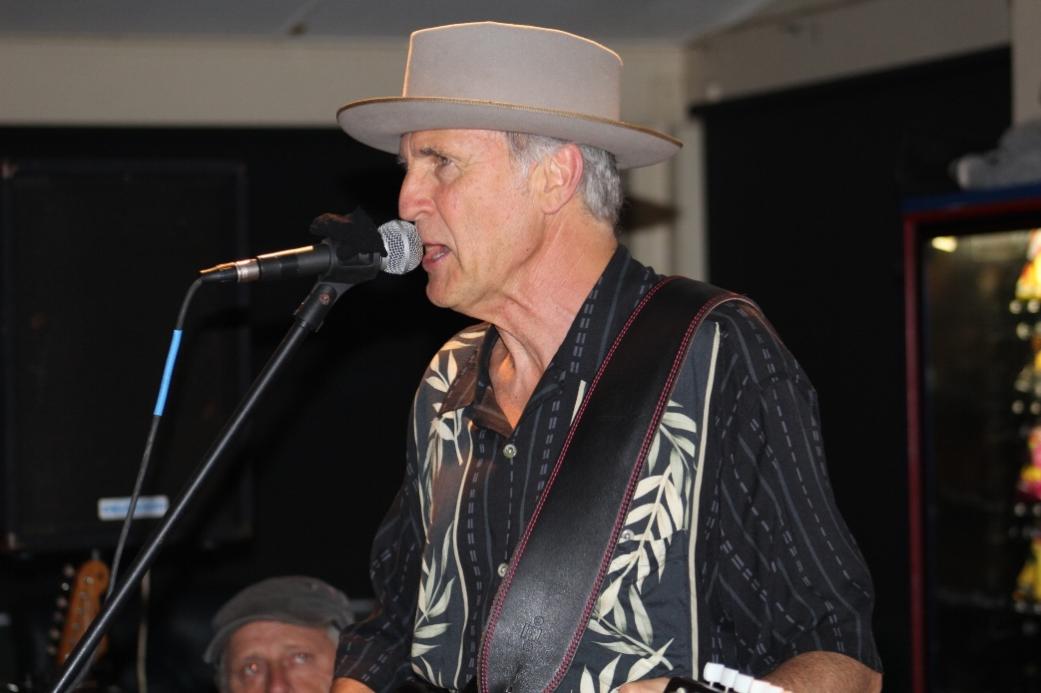
For decades some of the best music played around here has been made by a gentleman who passion and dedication to his art form has brought pleasure to thousands. For almost five decades Chris Raggatt has been perfecting his music and, although he’d state he’s still learning, he is also a sought after teacher.
Recently he won a spot to represent us all at the 2017 International Blues Challenge in Memphis, not an easy place to win.
Chris is also an aficionado on guitars themselves, has modified many of his own, or built them from scratch, and can repair those that have been damaged to such a high skill level you have look very closely to spot where the fracture in the wood grain may have once been.
He also knows about guitars – the history of them, what you can do with each different one, and how an instrument, after decades of being something music has been played through, mellows and produces great sounds.
Chris is pretty mellow himself. Quietly spoken, smiling when not deep inside a section of notes, he plays with exceptional musicians, many of whom have gigged together over decades. The result is exceptional music, and a strong local following every time he plays as a solo, Chris Raggatt or current ensemble on occasion, ‘C J and the Mellows’.
Chris has collated a few CD’s of his originals during the years, the most recent one just now available including a song he has written himself, a favourite we’d love to see more freely available – “Water and Earth”. It’s brilliant. Apparently Chris is just finalising the cover art for this CD.
This week a small insight into a local legend who provides insights into music itself. Chris also runs as our April 2017 Artist of the Month where some of his playlist may be sampled.
When and where were you born?
I was born in Adelaide, South Australia, in 1956.
Where did you grow up?
We lived in Adelaide for around my first 10 years and then moved to Melbourne and lived there for a few years and then moved to sunny tropical north Queensland, to Townsville. My teenage years were spent up there.
What did you do for fun?
There’s a tropical island off the coats of Townsville called ‘Magnetic Island’ so we’d go there. The countryside up there is beautiful, the mountains and streams.
I started playing music when I was 13, would play with my friends at school. When you’re into guitar you can live anywhere really – you’re into practicing, playing records to get ideas and learn more. Growing up in Townsville meant there weren’t so many distractions and you could also hear and view the music of the world from a subjective point of view; you weren’t so much immersed in a music scene with its influences or trends.
When I was 13 the English Blues thing was really happening – Janis Joplin, John Myall and the Bluesbreakers, with Eric Clapton playing with John Myall and the Bluesbreakers; these were huge influences on me.
I played with quite a few bands up there.
What was the name of some of these first ones?
One that comes to my mind is ‘Island’ which was the tropical influence. In those days, at school, all that you had for music was choir. Guitar and playing Blues or rock and roll was not really smiled upon, not at school at any rate – nothing like what happens now where the schools are much more progressive.
Where did your first guitar come from?
I had a wealthy godmother and she would send me money for Christmas and my birthdays. I saved this up and went and bought an electric guitar from a pawn shop in Townsville. It was a red guitar, Japanese made, I think it may have been a Teisco – I wish I still had it, it had four pickups and all these switches on it. this guitar was obviously second-hand – my dad made me clean it down with methylated spirits to make sure it was clean.
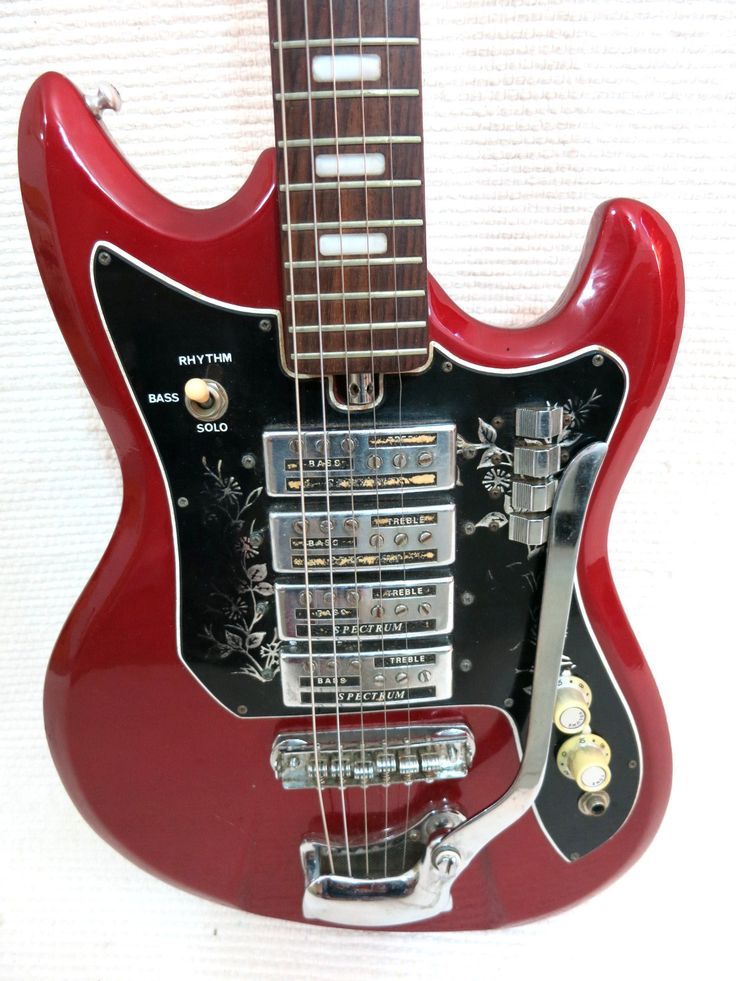
Teisco Spectrum 4 - 1960s Japanese guitar, four pickups
Where were you playing in Townsville?
At the James Cook University, do gigs in town and on Magnetic Island – we’d go over for the weekend and play at some of the resorts and stay over there. That was great, some great memories there. We’d take all our gear over on the ferry, play on the Saturday night, eat all this great food; fantastic tropical fruit, fresh fish.
How long were you in Townsville?
I left Townsville when I was 17. I bought a Combi van for 60 dollars, one of those two toned ones with the windows that folded out. We trekked from Townsville to Sydney. a friend of a friend had a place in Summer Hill, a really grotty old kind of house with huge cockroaches. We then moved over to near Balmain.
I remember cruising through Townsville and then down the coast, going through Byron Bay, which was a very quiet surfing hangout.
Were you a Hippy Chris?
Yes, definitely. I became a vegetarian, went the full mile really. The girl next door, whom I came down with, she was vegetarian, and was a huge influence on me. We cruised down eating salad sandwiches on wholemeal bread, enjoying the sights along the way.
Were you playing in bands when you came to Sydney?
Yes – I came to Sydney to check out the scene and see what I could see. It was a pretty funky time back then.
What was the music scene like in Sydney – what bands were you going to see play?
We saw many concerts – B.B. King and Ray Charles playing together, at Paddington I think that was. I also remember seeing ACDC too though at Checkers, and this was before they were famous and just getting it together. They had this little guy, who was their manager, I think he may have been Italian. He got up on stage and introduced the band and there would have been around 20 people in this club called ‘Checkers’ – definitely one of their earlier gigs.
Where did you first play in Sydney?
I met a drummer and we made a few connections and got a band going with him. I remember playing in a Blues band too.
We moved to Bondi for a while and then moved to Manly around 1979. I played in a band there that had some guys in it who I’d play with later on too. Then I played with Matt Finish – they became quite popular too around then.
What was Manly like in the late 1970’s?
We lived on Bower street, a great flat overlooking the water. It was a lot quieter then than it is now. There was a music shop in Brookvale called Barry Farrell’s – I had met some of the musicians around there then and one of these introduced me to the guitar repairers that repaired guitars for Barry Farrell – this was done in the workshop above the music store.
Since I’d started playing guitar I had always messed around with my own guitars, tweaked them and repaired them, customised them and so I had been repairing guitars for quite a few years by then. I met a guitar repairer working there, Rodney Gotten, and started working there – he had a lot of work on. That was a great experience working in that workshop, he taught me a lot. This was also a great social and musical scene.
Are you still doing guitar repairs for people?
I certainly am. People can contact me via email if they don’t have my contact details if they have some repairs that need doing
How many guitars do you estimate you’ve had and what are they all for?
(Chris sometimes has five guitars at the one gig)
A lot – too many to count.
For an example – that double neck guitar you see at some gigs is one I made with a friend of mine, John Cover. Because I play slide guitar and ordinary guitar, on some song I wanted to be able to play both slide and ordinary, so to have a double neck is really great as it allows me to do both and simply go between the two necks and the two sounds.
I also have some older ones that have had music coming out of them for so long they really begin to resonate – the wood gets used to being a musical instrument and starts to vibrate more freely.
I have some guitars that are made of steel as I like the sound of the steel guitar.
I have a 1936 National/Dark Wood guitar which I love – wonderful sound. I’d wanted one for ages and ages and just kept an eye out and managed to find one.
The reason I take five guitars to the one gig is that they’re all tuned differently, you need different guitars to cover different tunings; when you play slide guitar it has open tuning for example. Each instrument also has a different sound which will suit best a different song you’re playing and some will definitely suit some song more particularly. It can be a bit of a hassle taking so many instruments to the one gig but it means you can play different things using the different tuning and give your audience a wider range of music presented.
.jpg?timestamp=1491069615229)
What are your favourite three?
Well, because I make my own guitars and make them the way I like them, these would be my favourites; they produce the sound I was aiming for and can be used the way I want to use them.
I do have a lovely old 1930’s acoustic one that’s a favourite too. The other would be my 1936 National.
I do have a more recent resonator steel guitar that is alike the National guitar that I like too – that was made in China and is called a ‘Republic’! (laughs)
What is it about this one you like so much – the sound it produces?
Yes, it’s about the sound it can make, and its size, the way it has been made. It has been produced by a guy in America who has a lot of experience and been through a lot of research and had National guitars himself. The one I have is a small bodied one, like a three-quarters size, and has a short scale neck. I really like short scale necks as you can put fat strings on them and this gives them a really big fat sound. It also has a cutaway so you can get right up the neck, up high. I’ve put a National cone in it so it has that sound too. A resonator guitar is a guitar that has a cone in it which produces the sound really. This was produced by a guy in the late 1920’s, early 1930’s, called John Dopyera.
These guitars were designed and made before there were any Amps. Resonator guitars were designed to be really loud; they have a metal body which reflects the sound, and they resonate through this cone, which is shaped like a speaker, and so it has a great projection, and they also have this really eerie atmospheric sound that the Blues players really took to and made their work both easier and greater, particularly the National duonians – this was the second design that was made by Dopyera. So having put a National cone in this Republic guitar I can extend its capacity for sound – the original cone is very good but I prefer the sound it can now make.
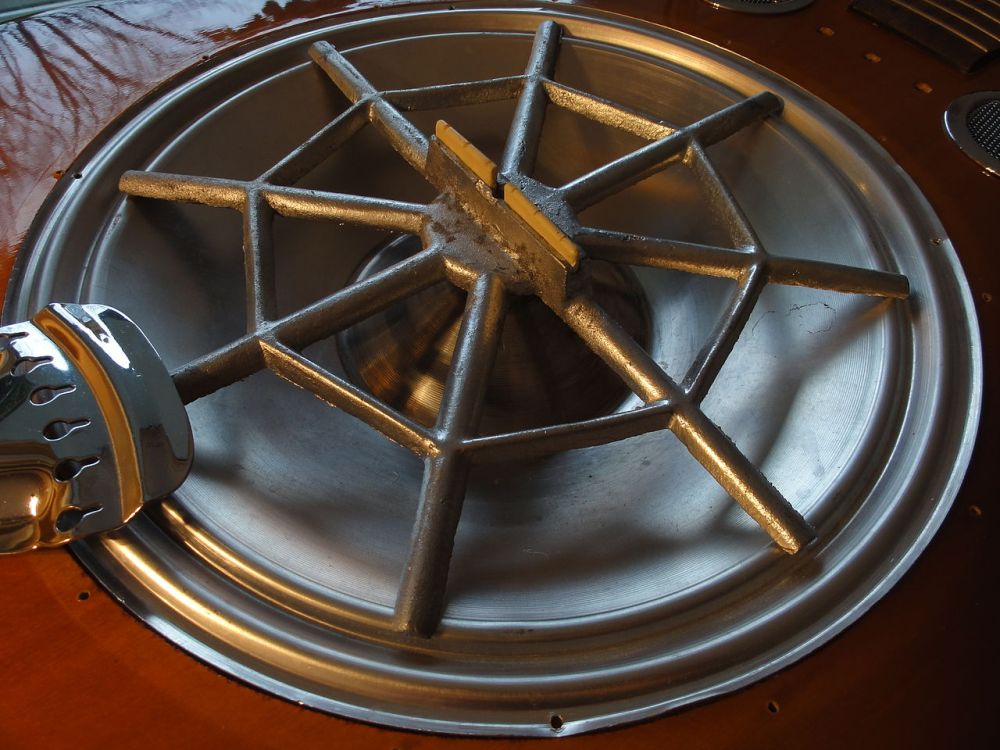
Spider resonator
Why the Blues Chris?
To me all good guitar playing has really come from playing the Blues on guitar – it stems from people like T Bone Walker, all those great black Blues guitar players. When I was 12 or 13 I bought myself a little radio, tied it on the front of my bicycle and would pedal around listening to this, to all the songs that would come on. One that comes to mind is Zager and Evans ‘In the Year 2525’.
Once I got a guitar I was into Jimmi Hendrix and Eric Clapton. I recall an interview with Eric Clapton where he was saying he felt like he had a role to bring the black African music to the world, to make people aware of this phenomenal sound. He sure did that for me, and for so many guitarists. He was listening to Muddy Waters, Howling Wolf and all that Memphis music. There were also the Rolling Stones developing their sound from these influences as well.
I too got into that music, but it was through them that I became aware of it – they were educating me. That has stuck.
In speaking of your gigs, the last one we saw was split into two halves – the first comprised what you termed ‘The Dinner Set’ and then the second half got everyone dancing. How do you decide what songs you will play where and when?
You have to play to the situation, or place you’re in – it may be a daytime gig, an afternoon one, an evening one – and different audiences in each place. When it’s on a Sunday afternoon people are chilled and relaxed. This is a great opportunity to play some beautiful instrumentals and more atmospheric acoustic pieces – we might do some more funky jazzy instrumentals which give the band a chance to play.
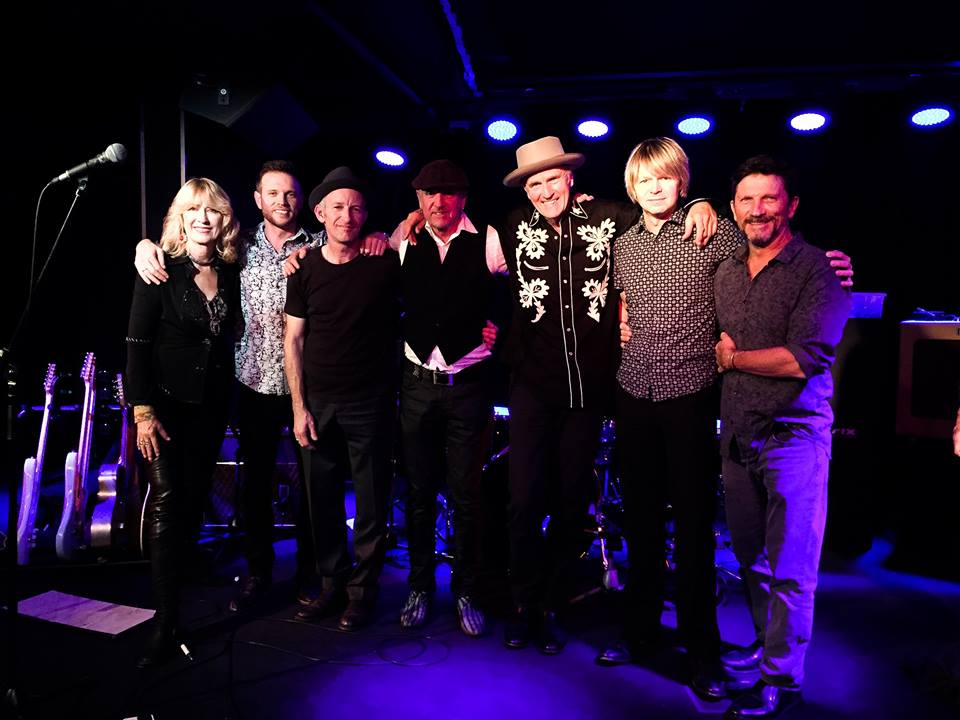
CJ and The Mellows at The Basement. 2016 Lineup. Photo by Tania Mant — with Robyn Fyfe, Rob Ewan, Antero Ceschin, Kelvin Anton Carlsson, Clayton Doley and David Poppleton.
Music has so many dimensions to it, and for the guys in my band, the piano player, the harp player and harmonica player and the guy on drums, they have all studied music in many different styles. It’s great to give everybody a chance to improvise and express themselves. So the early part of one of those afternoon gigs can be really fantastic as people may be talking and socialising and we can play this beautiful background music and be quietly exercising our range and enjoying, individually, each others playing and extend ourselves within that more jazzy instrumental genre.
Then you have to have some balance – so within that first set I like to do some blues shuffles which are a lot of fun and have a lot of life in them.
There is one played in your set that’s just wonderful – ‘Water and Earth’– where is that from? It’s just outstanding.
That’s one of my own originals.
How long have you been writing music and songs?
A long time. I have books filled with lyrics that go way back. To put a time on it, some go back 40 or more years.
Are any of these available?
I’ve done a couple of CD’s over the years and am recently recorded another to take to America.
Is that song going to be on it?
Yes, it is. We played the Thredbo Blues Festival in January and had it available first there. This festival has been running for a number of years and it’s a great place and great music. People may not realise how beautiful this place is outside of the snow season – all the wildflowers, and the ski lift is going so you can go up to the top and go for walks.
You were selected to be part of the 2017 International Blues Challenge – how did this happen?
The Sydney Blues Society has a competition here every year in which there’s a solo, duo and band section in which you can enter. This year there were 7 acts in the solo duo section and we were lucky enough to win.
Who is going with you?
Kelvin Carlsson, a harmonica player. Kelvin is a friend of Milton’s. Milton Brown said he knew this harmonica player who wanted to come down and have a jam and sit in on a gig – I said ‘sure!, let’s do it’ . he came down and sat in on a gig at Avalon Bowlo and was just great, just really really right. Kelvin has played the harmonica for years and is really dedicated, really into it. he has his gear sorted out, a great amplifier to play his harmonica through and has a great style, always dresses for the part – and he goes off on his harmonica.
He transports himself and his music with his harmonica in a great way. He is just a spark of energy.
We really had a connection, had a similar approach I suppose in that we’re both going for that feeling of energetic release when we play – we’re going for it. When this happens it moves above just being great music, there’s some kind of spiritual release that happens too.
So what will you be doing at the 2017 International Blues Challenge?
Evidently there will be around 900 Blues musicians converging on Memphis, so you have to make sure you book early for accommodation. There will be over 250 acts and some competitions, some concerts, some forums and tutorials or talks with musicians. There will be producers and record companies there, people that are really in the know, in the industry, so it’s a great experience as well.
In the competition or Challenge there are quarter finals and semi finals and finals.
Ultimately it’s a great way to meet people with a similar passion form all over the world.
When you’re a musician you basically dedicate your life to your passion; to your instrument, to your music, to doing it as best you can. So it’s really great when you can spend time with people who have done the same thing, who have dedicated their lives to their love of music.
Kelvin Anton Carlsson posted this n behalf of himself and Chris on February 5th:
Our competition gigs finished on Thursday night, and CJ & I had a blast but didn't make the semi finals. PJ Obrien Band (along with 2 other Aussie acts) made itthrough to the semi's, go Oz! PJ & the lads were on fire but unfortunately didn't make the finals. It's been the most amazing experience playing here, watching all the other acts, and meeting some wonderful people from all over the US & the world. Just like to thank all the people who supported us getting here, those who came to our fundraisers, The Sydney Blues Society & the bands who played at the fundraisers. Without you all this wouldn't have been possible. We leave here inspired, and with a deeper understanding & appreciation of the rich musical heritage of Memphis & the south. Tonight we are playing with the PJ Obrien band down in Clarksdale, Mississippi. Thanks y'all! Cheers, Kel & Chris.
What are your favourite places in Pittwater and why?
I have quite a few, I’ve been here a long time. Sunset Rock would be one.
At the moment I love going down the fisherman’s track between Whale Beach and Palm Beach down onto the rocks beside the water – it’s great being so close to the ocean and among those amazing rocks that are there. I’d like to do a film clip down there.
There’s also a great lookout on the northern end of Whale Beach as well that is a favourite place.
And of course the places we’ve played at are pretty special too. I’ve been very lucky in that the people in this area are very generous in coming to gigs and the owners of so many places are so supportive of local musicians and providing music for people. We get to play at Modus Operandi at Mona Vale, do gigs at Yoda in Avalon and the Avalon Bowlo, and Dave Shaw, the drummer out of Nothing Too Serious has just bought a place at Newport called Group Therapy and is doing this up. There’s just a great scene that’s always been around and keeps being carried forward and developed by this backbone of local business people. This really helps the musicians as times have changed and there aren’t as many gigs around as there used to be, so opening these smaller spots, these cafes and restaurants to live music, gives everyone a chance to play or hear music and gives the musicians a chance to make a living while at the same creating more culture where we live rather than having to travel to experience that.
What is your ‘motto for life’ or a favourite phrase you try to live by?
It does change over time but one I have at the moment is ‘The Present holds the key to Liberation’.
To me this is if you bring yourself and keep yourself in the present than you have an opportunity to do what you want to do, and in reality, the present is all we’ve got – all else has already gone or not yet arrived. So when you’re making music, when you’re recording, being in the moment is going to produce the best results – Be Here Now.
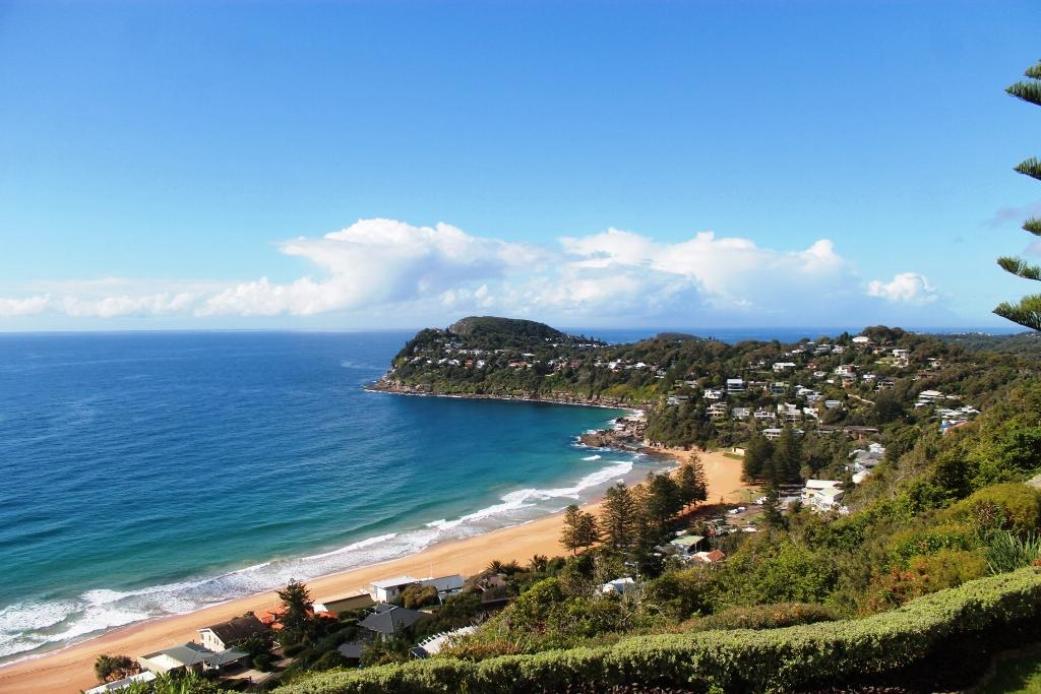
2017 International Blues Challenge
January 31 & February 1- 4
Takes place in various clubs on Beale Street
Finals at The Orpheum Theatre
The Blues Foundation, is world-renowned as THE organization dedicated to preserving blues music history and celebrating recording and performance. The International Blues Challenge is the Blues Foundation's signature event that turns all of Beale Street into a four-day big blues venue for more than 120 blues acts from around the world.
The 2017 International Blues Challenge will be the 33rd year of Blues musicians from around the world competing for cash, prizes, and industry recognition. The world's largest gathering of Blues acts represents an international search by The Blues Foundation and its affiliated organizations for the Blues Band and Solo/Duo Blues Act ready to take their act to the international stage.
Acts fill the clubs up and down Beale Street for the quarter-finals on Wednesday and Thursday, the semi-finals on Friday and the finals at the Orpheum Theater on Saturday. Visit: https://blues.org/
Sydney Blues Society – CJ Raggatt and Kelvin Carlsson 2017 Solo/Duo- https://blues.org/2017-ibc-entries/
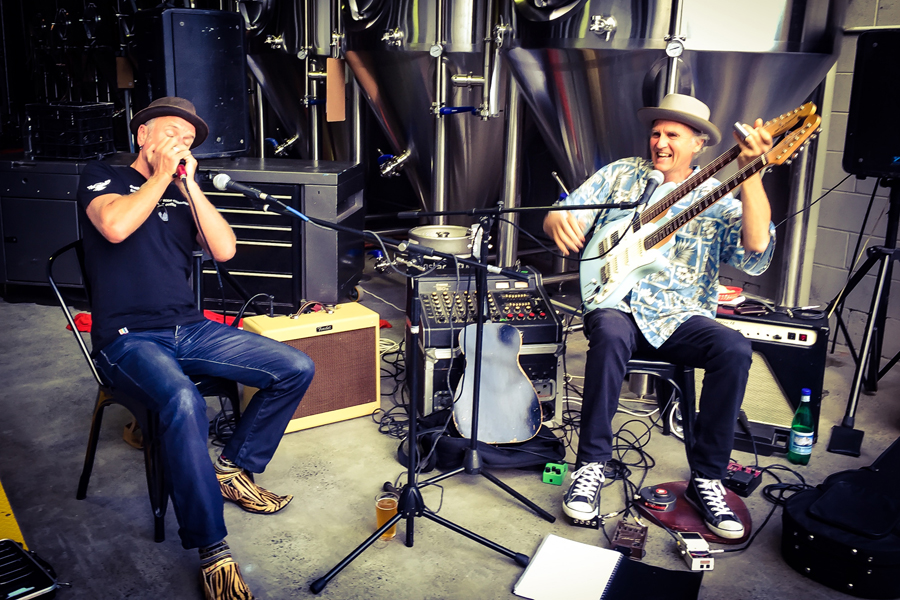
C J and Kel
Chris Raggatt - Music Teacher and Guitar Healer
Instruments/Services: Guitar, Bass
Styles: Blues, Classical, Jazz, Rock
Suburb: Whale Beach
Phone: 0407 144 549
Email: cjraggatt@gmail.com
A resonator guitar or resophonic guitar is an acoustic guitar that produces sound by carrying string vibration through the bridge to one or more spun metal cones (resonators), instead of to the sound board (guitar top). Resonator guitars were originally designed to be louder than regular acoustic guitars, which were overwhelmed by horns and percussion instruments in dance orchestras. They became prized for their distinctive sound, however, and found life with several musical styles (most notably bluegrass and the blues) well after electric amplification solved the issue of inadequate guitar sound levels.
Resonator guitars are of two styles:
Square-necked guitars played in lap steel guitar style
Round-necked guitars played in conventional guitar style or steel guitar style
There are three main resonator designs:
The tricone, with three metal cones, designed by the first National company
The single-cone "biscuit" design of other National instruments
The single inverted-cone design (also known as a spider bridge) of Dobro brand instruments and instruments that copy the Dobro design
.jpg?timestamp=1491067611186)
1st National resophonic guitar (c. 1926-7). Courtesy Museum of Making Music
John Dopyera—responding to a request by the steel guitar player George Beauchamp—developed the resonator guitar to produce an instrument that could produce sufficient volume to compete with brass and reed instruments. Dopyera experimented with configurations of up to four resonator cones and with cones composed of several different metals.
In 1927, Dopyera and Beauchamp formed the National String Instrument Corporation to manufacture resonator guitars under the brand name "National". The first models were metal-bodied, and featured three conical aluminum resonators joined by a T-shaped aluminum bar that supported the bridge—a system called the tricone. National originally produced wooden-bodied Tricone models at their factory in Los Angeles, California. They called these models the Triolian, but made only 12 of them. They changed the body meant for tricones to single-cone models, but kept the name.
In 1928, Dopyera left National to form the Dobro Manufacturing Company with his brothers Rudy, Emile, Robert, and Louis, "Dobro" being a contraction of Dopyera Brothers' and also meaning "goodness" in their native Slovak language. Dobro released a competing resonator guitar with a single resonator with its concave surface uppermost, often described as bowl-shaped, under a distinctive circular perforated metal cover plate with the bridge at its centre resting on an eight-legged aluminium spider. This system was cheaper to produce, and produced more volume than National's tricone.
National biscuit
National countered the Dobro with its own single resonator model, which Dopyera had designed before he left the company. They also continued to produce the tricone design, which many players preferred for its tone. Both National single and tricone resonators remained conical, with their convex surfaces uppermost. Single resonator models used a wooden biscuit at the cone apex to support the bridge. At this point, both companies sourced many components from Adolph Rickenbacher, including the aluminium resonators.
National Dobro, Hound Dog, and Gibson
After much legal action, the Dopyera brothers gained control of both National and Dobro in 1932, and subsequently merged them into the "National Dobro Corporation". However, they ceased all resonator guitars production following the U.S. entry into World War IIin 1941.
In the late 1980s, the National brand and trademark reappeared with the formation of National Reso-Phonic Guitars. The company produces six-string resonator guitars of all three traditional resonator types, focusing on reproducing the feel and sound of old instruments. Its other resonator instruments include a 12-string guitar, ukuleles and mandolins.
Australia
Wayne Acoustic Guitars produced a spider bridge resonator guitar in the 1940s and 1950s in Australia. They were crudely made out of what was at the time cheap Australian timber using a tone ring rather than a tone well but their biggest problems were no neck reinforcement and a very different pressed (rather than spun) cone. This is often called a pillow cone due to the shapes pressed into the face to strengthen the cone. Many examples exist today and if the neck is straight and a good cone is used can give a reasonable sound. As of 2010, Don Morrison was producing highly regarded resonators under the Donmo brand name.
Asia
Asian brands such as Regal, Johnson, Recording King, Republic Guitars, Rogue and Royall also produce or import a wide variety of comparatively inexpensive resonator guitars. Johnson has also produced resonator ukuleles and mandolins.
Resonator guitar. (2017, January 16). In Wikipedia, The Free Encyclopedia. Retrieved from https://en.wikipedia.org/w/index.php?title=Resonator_guitar&oldid=760303573